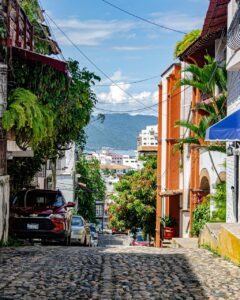More and more Americans are now heading south and living in border towns in Mexico. And people from the U.K. and other parts of Western Europe are relocating to Eastern Europe for the same reason: a lower cost of living. If you are already retired or can work remotely, do an online business or side hustles, or you have some skills that allow you to freelance in your destination county (such as tutoring in English), then you should consider moving to a country that you can afford.
Here’s a brief overview about becoming a digital nomad:
I used to work with a lady who had retired friends who spent their winters in the Czech Republic because they liked skiing and the cost of living was much lower, allowing their retirement incomes to go a lot farther. (This is not uncommon; a growing number of Americans are retiring to Mexico or English-speaking Belize because the cost of living is lower. There are entire communities full of ex-pats.) They tried to save up their medical, dental, and eye exams for when they were there as well, as medical and drug costs were much lower than they would pay stateside. (This is also known as “medical tourism” and you should have no trouble Googling the term and your country of choice to find recommended medical providers who speak English, are affordable out-of-pocket, and who may qualify for reimbursement from some U.S. health insurance providers.)
 A small income that might not rent a room in a house with multiple roommates in California could get you a pretty nice apartment all to yourself right across the Mexican border.
A small income that might not rent a room in a house with multiple roommates in California could get you a pretty nice apartment all to yourself right across the Mexican border.
Prices are going to vary seasonally, with the most touristy places often doubling in price during the in-season versus the off-season. So, unless the in-season price is still within your price-range, plan on relocating every 6 months to some other place’s off-season.
What about visas and such? There are a lot of places Americans (and Canadians and Europeans, too, for that matter) can go with just their passport; a separate visa application is not needed. This makes life easier because these tourist entry stamps usually grant you a 3 month stay. When you are almost out of time, “reset” your stamp by taking a weekend trip to another nearby country, then re-enter your host country, thus getting another 3 months. (Although do consult the rules where you are going to be living, because some countries may limit the overall amount of time you can spend there in a 1-2 year period, so after pulling this trick two or three times, you may have to go somewhere else for 6 months or more before you get a reset.)
Countries where visas are required will be trickier since you have to do paperwork for it and then wait on it to be approved; you can’t reset them by simply leaving for a weekend. In those cases, you may need to plan to move more often, or see what it will take to get a visa that will last as long as you want to stay.
Speaking of Americans living across the border, this is an interview of a gentleman who grew up in NYC and, after living his adult life in California, retired to Latin America. He lived in Mexico for several years and toured around all of South America before settling in Brazil. He lives on $500 a month (and this includes $80 a month that he gives to help out a young niece) in one of the smaller, interior cities in Brazil. His expenses include his rent for a new, ground-floor, 2-bedroom condo with a small private garden and access to a pool and gym. Medicare doesn’t cover his medical procedures or prescriptions in the country, but healthcare is free in Brazil—even for foreigners—and he can easily afford to pay for his prescriptions out of pocket. (He was also able to pay out of pocket to see a specialist.)
The drawback, as he mentioned later in the comment section, is that he could not function in the small city where he lives without the ability to speak fluent Portuguese. If you need to live in a larger city where you can find people that speak English, that will cost you more.
Here’s a tour of Lombok, Indonesia with prices for long-term rentals, food, transportation, gym facilities, etc. The area is very clean, appears to be safe, has a beautiful beach, and the locals are very friendly and speak English. They cater to tourists, but it seems that, for now, they’re aimed at more low-budget tourists, like surfers and young travelers, which means a low cost of living if you choose to live there.
Here’s an overview of the cost to live in Bali, Indonesia in permanent housing, along with a sample of grocery costs, the cost to eat out or have drinks on the beach, utility and phone costs, monthly transportation costs, and the often-overlooked cost of doing laundry. Bali is an international tourist destination, so it should be easy enough to navigate there in English.
Here is another video on the costs associated with living in Bali for a retired man. You can’t beat the rates this guy is paying for housing. He has good advice for making friends with the locals; they will let you know about good deals on houses, the best places to eat, the nicest places to visit, etc.
If a small town isn’t really your thing, check out this tour of the city of Kuala Lumpur in Malaysia. You’re going to pay more to be in a large, vibrant city than in a local beach town, but the rent for a condo is still insanely cheap compared to rent in the United States, especially what you would pay in a similar-sized American city. Every amenity you could want seems available: high-end shopping, lovely parks, sidewalk cafes featuring cuisine from all over the world, wi-fi, DoorDash, and everything seems to be written in English, and English seems commonly-spoken.
This isn’t a full tour of Pattaya, Thailand, but it is a tour of a luxury studio condo with beach views for a mere $280 per month.
If you’re not a tropical island sort of person, then you might want to check out India. Outside the largest cities, which have cost of living rates on par with some of the larger cities in the U.S., you can save 60% or so compared to living in America. This video does a comparison between prices in India and Austin, TX. Included is a mention of health insurance and medical costs.
English is actually one of the official languages in India, so you will find it on government paperwork, and it’s the most-commonly spoken second language. (That being said, the more rural you go, the harder it will be to find someone who speaks reasonably good English because the poorest people in India do not spend a lot of time in school where they can learn it.).
My late husband spent nearly 3 months in India, in two different cities, for work, and he loved his time there. He didn’t have any problems getting around, and the only time he got sick was, oddly enough, when he got some Italian food from a restaurant. It did help that he loved spicy food!
If the thought of going to a foreign country all by yourself is a little intimidating, check out the Madeira Islands off the coast of Morocco (although they belong to Portugal). They have created a program to attract digital nomads (i.e. people who work remotely) to their beautiful islands and they offer a lot of assistance, such as getting leasing contracts in your native language so you can understand what you’re signing, easy immigration paperwork, free co-working spaces, etc.
You don’t have to worry about being lonely; there are all sorts of activities going on that serve as nomad meet-ups, such as hiking groups, yoga classes, nightclub parties, brunches, etc., and they have online community boards so it’s easy to find out what’s happening when. The islands aren’t exclusively made up of digital nomads, but there appear to be a large contingency of them, so they’re not hard to find. And as most of them are from various parts of Europe, English seems to be the default language because it’s what they have in common (the same is true in India, which has hundreds of languages and even more dialects; when Indians travel, they usually end up speaking English to one another), so there doesn’t appear to be a language barrier if English is all you speak. (Although this would be a good opportunity to pick up a second language if there’s one you’ve always wanted to learn; it looks like it would be easy to find a language partner.)
One resident in the village of Ponta del Sol (which seems to be the epicenter of the digital nomad community) estimated that if you live cheaply, you should be able to get by with about $1,000 per month. If you want to do more activities, have a larger home, eat out more, travel on the weekends, etc., then you might need upwards of $2,000 per month. So this location is not as cheap as some of the southeast Asian locations we’ve previously looked at, but it’s certainly on par with the cheapest places to live in the U.S. And nothing says you have to stay there. You could approach it as your entryway into international living; once you get comfortable with it, then you can feel more confident setting off to another country which has a lower cost of living, but doesn’t have the safety net of programs aimed at digital nomads.
A brief overview of Ponta del Sol:
Check out other videos on this same channel for more information on the Madeira Islands and interviews with digital nomads. The official website for the movement, with lots of needed information, is: https://digitalnomads.startupmadeira.eu/
Is international living infeasible or not your cup of tea? Check out this post for more cheap living options a little closer to home. On the Road Again – Exploring Nomadic Housing Options


